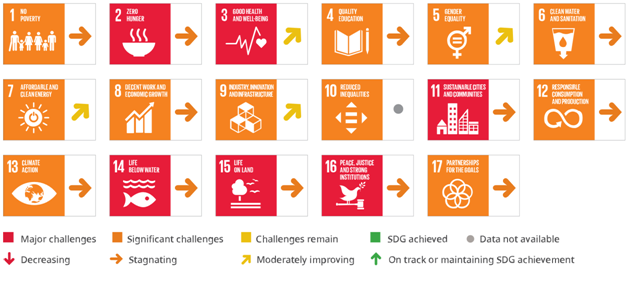Sustainable development goals report 2025
Why in News?
As per the UN 10th Sustainable Development Report (SDR) 2025, (released by the UN Sustainable Development Solutions Network SDSN) India ranks 99th in the Sustainable Development Goals (SDG) Index,
India marking its first time in the top 100 out of 167 countries with a score of 67.
Highlights of the Sustainable Development Report 2025
- The SDG progress has stalled at the global level, with only 17 per cent of the 17 targets adopted by the U.N. member countries in 2015 projected to be achieved by 2030.
- Many European countries face significant challenges including those related to climate and biodiversity, largely due to unsustainable consumption.
- East and South Asia have outperformed all other global regions in terms of SDG progress since 2015 largely due to rapid socioeconomic development.
- Only 35% of SDG targets are on track or making moderate progress. Nearly half are moving too slowly and 18% have regressed from 2015 levels.
- Millions of lives have improved: There have been important gains in access to education, maternal and child health, digital connectivity, and electricity. The global working poor has been reduced by 20 million since 2015, and over half the world’s population now enjoys some form of social protection.
- Inequality and setbacks: Extreme poverty, hunger, inadequate housing, and lack of basic services persist globally. Vulnerable groups—women, people with disabilities, and marginalized communities—still face systemic disadvantages
- Global development emergency: Escalating conflicts, record-breaking global temperatures, increasing debt burdens, and a widening annual SDG financing gap (now estimated at $4 trillion USD) threaten further advancement.
- Regional trends: East and South Asia have shown the fastest progress since 2015, especially in socioeconomic targets. European countries continue to top the SDG Index (Finland ranks first in 2025), though no country is on track to achieve all goals
- SDG priorities for acceleration: Six priority areas where action is most needed: food systems, energy access, digital transformation, education, jobs and social protection, and climate and biodiversity
- The report said the top three countries most committed to the UN multilateralism are Barbados (1), Jamaica (2) and Trinidad and Tobago (3).
- Among G20 nations, Brazil (25) ranks highest, while Chile (7) leads among OECD countries.
Top Performers:
- (1st) Finland ,
- (2nd) Sweden ,
- (3rd) Denmark ;
(notably, 19 out of the top 20 countries are European)
India’s Regional Standing
- East and South Asia have shown the fastest regional progress since 2015—India ranks ahead of Bangladesh (114th) and Pakistan (140th) but trails Bhutan (74th), Nepal (85th), Sri Lanka (93rd), and Maldives (53rd).
National Milestones
- India climbed to 99th position out of 167 countries in the 2025 Sustainable Development Goals (SDG) Index—its first time in the global top 100, reflecting marked progress from previous years (109th in 2024, 112th in 2023).
- Overall SDG Index score for India in 2025 is 67 (on a scale where 100 indicates full achievement of all 17 goals.
- This improvement highlights successes in poverty reduction, healthcare, clean energy access, and social protection.
Key Achievements
- Social Protection: Population coverage by social protection systems/floors rose from 22% in 2016 to 64.3% in 2025, indicating expanded social security.
- Agricultural Productivity: Gross Value Added in agriculture per worker rose from ?61,247 in 2015–16 to ?94,110 in 2024–25.
- Safe Drinking Water (Rural): Access increased from 94.57% (2015–16) to 99.62% (2024–25).
- Renewable Energy: Share in total installed generation rose from 16.02% (2015–16) to 22.13% (2024–25); per capita renewable capacity increased from 64.04W (2014–15) to 156.31W (2024–25).
- Waste Management: Number of waste recycling plants grew from 829 (2019–20) to 3,036 (2024–25); waste processing improved from 17.97% (2015–16) to 80.7% (2024–25).
- Digital Access: Internet subscriptions surged from 302 million (2015) to 954 million (2024), fueling digital inclusion.
- Income Inequality: Gini coefficient for household expenditure fell in both rural (0.283 to 0.237) and urban (0.363 to 0.284) areas between 2011–12 and 2023–24.
- Forest Cover: Increased marginally from 21.34% (2015) to 21.76% (2023).
- Emissions Intensity: Dropped 36% in 2020 compared to 2005, marking strong progress toward a low-carbon economy.
Policy and Institutional Advances
- National Indicator Framework (NIF): India’s SDG monitoring relies on a robust NIF updated annually, coordinating across government bodies for data and accountability.
- NITI Aayog: Coordinates SDG implementation, tracks state and UT progress, and helps identify priority areas.
- UN-India Partnership: The UN provides technical support, especially to align policies with the “leave no one behind” principle
Conclusion
India’s progress on the SDGs in 2025 is marked by clear advances in social protection, clean energy, digital access, and reduced inequality, supported by robust institutional frameworks. Major gaps persist in nutrition, education, gender, and climate action, requiring targeted reforms and concentrated financing to achieve the 2030 Agenda’s vision.
Download Pdf




